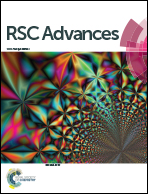Molecular mechanism of CO2 absorption in phosphonium amino acid ionic liquid†
Abstract
In this investigation, we examine the molecular mechanism of high pressure CO2 absorption in tetra-butylphosphonium lysinate Ionic Liquid (IL) using molecular dynamics simulations. The calculations show that on CO2 absorption, a structured bilayer of charges (in opposite phases) at the CO2–IL interface is formed. The interface formation starts within a short span of tens of picoseconds, and attains saturation around ten nanoseconds, where CO2 molecules remain absorbed in the bulk IL layers. The simulations predict a 0.9 molar absorption of CO2 at T = 298 K and pCO2 = 20 bar, with a further increase of 17% at a reduced temperature. The structural properties show that CO2 molecules strongly and preferentially interact with the two terminal amine sites of the anions, where the presence of carboxylate group further enhances CO2 absorption. The interaction and absorption of CO2 molecules leads to enhanced mobility of the cations and anions of the IL. The mobility of anions is slightly higher than cations due to the preferential interaction of CO2 molecules with anions. The molecular mechanism examined in this work can be used as a predictive tool to develop efficient amino acid functionalized ILs for CO2 absorption.


 Please wait while we load your content...
Please wait while we load your content...